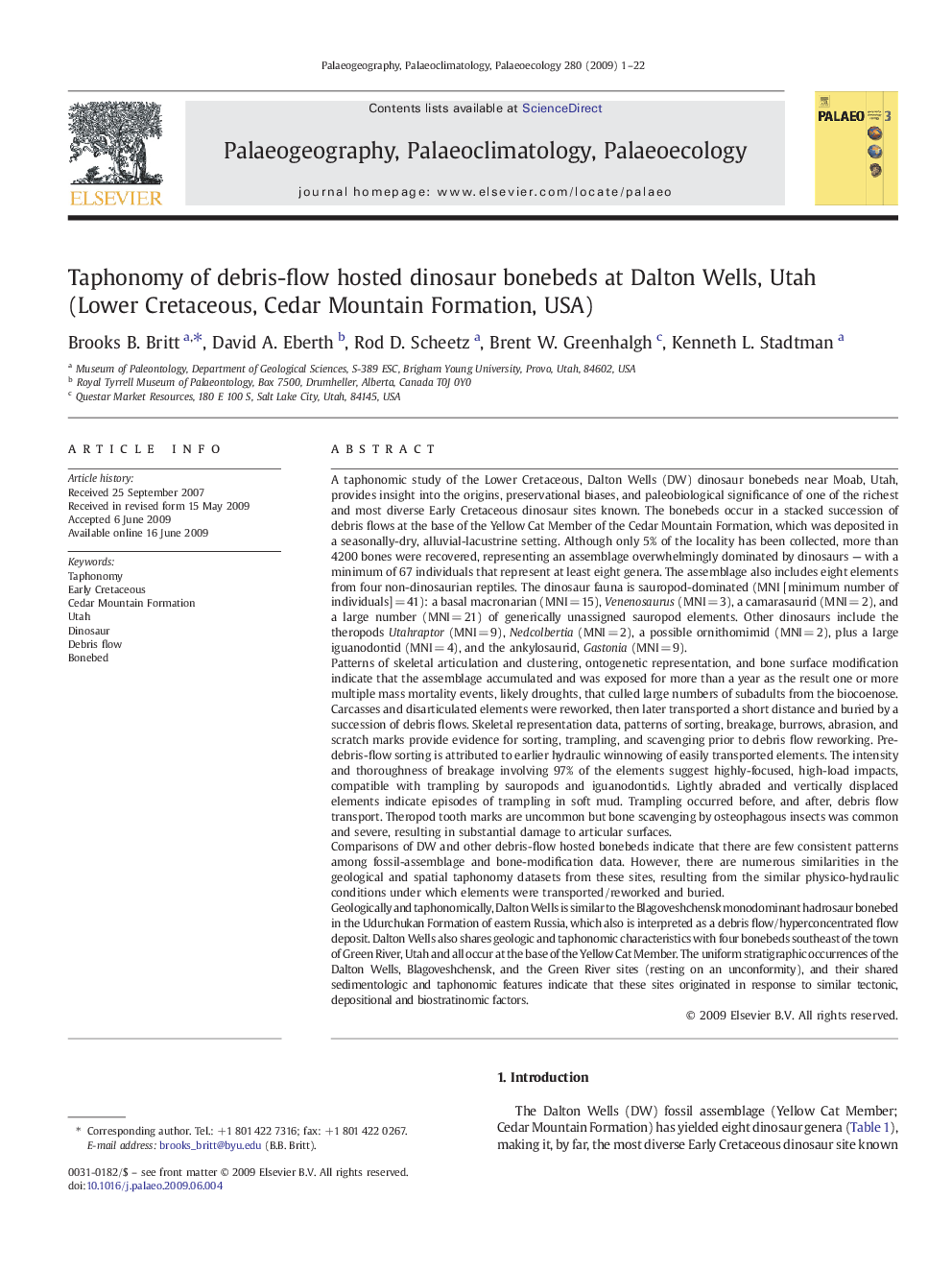| کد مقاله | کد نشریه | سال انتشار | مقاله انگلیسی | نسخه تمام متن |
|---|---|---|---|---|
| 4468031 | 1622297 | 2009 | 22 صفحه PDF | دانلود رایگان |

A taphonomic study of the Lower Cretaceous, Dalton Wells (DW) dinosaur bonebeds near Moab, Utah, provides insight into the origins, preservational biases, and paleobiological significance of one of the richest and most diverse Early Cretaceous dinosaur sites known. The bonebeds occur in a stacked succession of debris flows at the base of the Yellow Cat Member of the Cedar Mountain Formation, which was deposited in a seasonally-dry, alluvial-lacustrine setting. Although only 5% of the locality has been collected, more than 4200 bones were recovered, representing an assemblage overwhelmingly dominated by dinosaurs — with a minimum of 67 individuals that represent at least eight genera. The assemblage also includes eight elements from four non-dinosaurian reptiles. The dinosaur fauna is sauropod-dominated (MNI [minimum number of individuals] = 41): a basal macronarian (MNI = 15), Venenosaurus (MNI = 3), a camarasaurid (MNI = 2), and a large number (MNI = 21) of generically unassigned sauropod elements. Other dinosaurs include the theropods Utahraptor (MNI = 9), Nedcolbertia (MNI = 2), a possible ornithomimid (MNI = 2), plus a large iguanodontid (MNI = 4), and the ankylosaurid, Gastonia (MNI = 9).Patterns of skeletal articulation and clustering, ontogenetic representation, and bone surface modification indicate that the assemblage accumulated and was exposed for more than a year as the result one or more multiple mass mortality events, likely droughts, that culled large numbers of subadults from the biocoenose.Carcasses and disarticulated elements were reworked, then later transported a short distance and buried by a succession of debris flows. Skeletal representation data, patterns of sorting, breakage, burrows, abrasion, and scratch marks provide evidence for sorting, trampling, and scavenging prior to debris flow reworking. Pre-debris-flow sorting is attributed to earlier hydraulic winnowing of easily transported elements. The intensity and thoroughness of breakage involving 97% of the elements suggest highly-focused, high-load impacts, compatible with trampling by sauropods and iguanodontids. Lightly abraded and vertically displaced elements indicate episodes of trampling in soft mud. Trampling occurred before, and after, debris flow transport. Theropod tooth marks are uncommon but bone scavenging by osteophagous insects was common and severe, resulting in substantial damage to articular surfaces.Comparisons of DW and other debris-flow hosted bonebeds indicate that there are few consistent patterns among fossil-assemblage and bone-modification data. However, there are numerous similarities in the geological and spatial taphonomy datasets from these sites, resulting from the similar physico-hydraulic conditions under which elements were transported/reworked and buried.Geologically and taphonomically, Dalton Wells is similar to the Blagoveshchensk monodominant hadrosaur bonebed in the Udurchukan Formation of eastern Russia, which also is interpreted as a debris flow/hyperconcentrated flow deposit. Dalton Wells also shares geologic and taphonomic characteristics with four bonebeds southeast of the town of Green River, Utah and all occur at the base of the Yellow Cat Member. The uniform stratigraphic occurrences of the Dalton Wells, Blagoveshchensk, and the Green River sites (resting on an unconformity), and their shared sedimentologic and taphonomic features indicate that these sites originated in response to similar tectonic, depositional and biostratinomic factors.
Journal: Palaeogeography, Palaeoclimatology, Palaeoecology - Volume 280, Issues 1–2, 1 September 2009, Pages 1–22